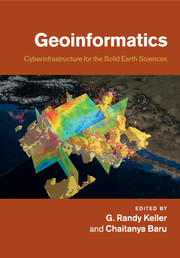Book contents
- Frontmatter
- Contents
- List of contributors
- Preface
- Introduction
- Part I Case studies from other disciplines
- Part II Modeling software and community codes
- Part III Visualization and data representation
- Part IV Knowledge management and data integration
- Part V Web services and scientific workflows
- Part VI Emerging international and other efforts
- 18 It's not your data, it's everyone's: The benefits of a corporate approach to scientific information
- 19 TOPO-EUROPE and cyberinfrastructure: Quantifying coupled deep earth – surface processes in 4-D
- 20 OneGeology – from concept to global project
- 21 Geoinformatics developments in Germany
- 22 iGEON: Networking the Indian geosciences community through GEON
- 23 Geoinformatics in the public service: Building a cyberinfrastructure across the geological surveys
- 24 Application of the US Geoscience Information Network to deploying a national geothermal data system
- Index
- Plate section
- References
23 - Geoinformatics in the public service: Building a cyberinfrastructure across the geological surveys
from Part VI - Emerging international and other efforts
Published online by Cambridge University Press: 25 October 2011
- Frontmatter
- Contents
- List of contributors
- Preface
- Introduction
- Part I Case studies from other disciplines
- Part II Modeling software and community codes
- Part III Visualization and data representation
- Part IV Knowledge management and data integration
- Part V Web services and scientific workflows
- Part VI Emerging international and other efforts
- 18 It's not your data, it's everyone's: The benefits of a corporate approach to scientific information
- 19 TOPO-EUROPE and cyberinfrastructure: Quantifying coupled deep earth – surface processes in 4-D
- 20 OneGeology – from concept to global project
- 21 Geoinformatics developments in Germany
- 22 iGEON: Networking the Indian geosciences community through GEON
- 23 Geoinformatics in the public service: Building a cyberinfrastructure across the geological surveys
- 24 Application of the US Geoscience Information Network to deploying a national geothermal data system
- Index
- Plate section
- References
Summary
The need for a national geoscience information network
Geologic data and information are required to find effective scientific solutions to the challenges that society faces today, whether it is developing new sources of energy, sustaining mineral and water resources, mitigating natural hazards, or anticipating climate change. Even when environmental data for a given area are readily available, they are often exceptionally difficult to discover and may exist in different formats and via different services, with different access conditions. The cost and time needed to manually find, assemble, and reformat data are considerable, and many times these data are needed to respond quickly to an issue or emergency.
In early 2007, the Federal and State geological surveys in the United States agreed to the development of the U.S. Geoscience Information Network (http://usgin.org, http://lab.usgin.org) as a data integration framework that is distributed, interoperable, uses open-source standards and common protocols, respects and acknowledges data ownership, fosters communities of practice, and is based on web services and clients (Allison et al., 2008a). This common approach enhances the geoscience community's ability to coordinate within and across scientific domains and, as service-oriented architecture (SOA) designs become more common, it can be fully integrated with the growing global cyberinstructure. The “USGIN” as the network has come to be known, has attracted a large number of collaborators across government, industry, and academic institutes and working groups, including such organizations as the U.S. Department of Energy, Energistics, Inc., Microsoft Research, and the San Diego Supercomputer Center.
- Type
- Chapter
- Information
- GeoinformaticsCyberinfrastructure for the Solid Earth Sciences, pp. 342 - 349Publisher: Cambridge University PressPrint publication year: 2011

